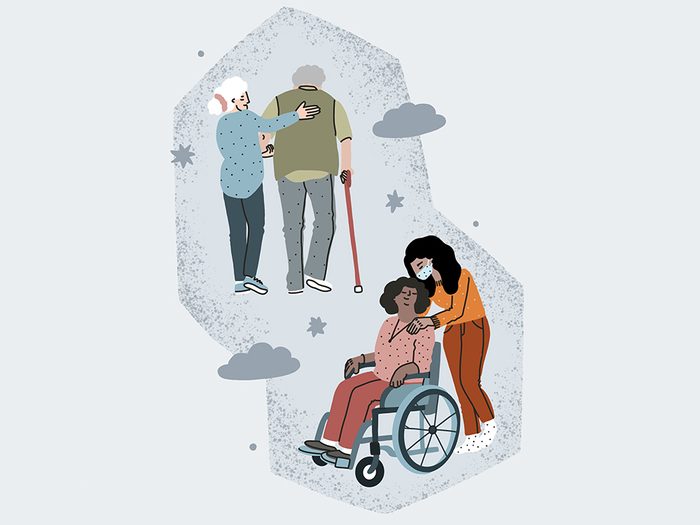How Are Canadian Caregivers Handling COVID?

Covid-19 has changed the way Canadians care for children and adults living with a disability. Here's why they need our help now—and after the pandemic.
When Edmonton schools shut down due to the coronavirus last March, Kevin Metz and his wife, Tammy, knew they were in for a bigger challenge than most. The Metzes are parents and caregivers to 12-year-old Parker and nine-year-old Preston, who both have obsessive-compulsive disorder and attention deficit hyperactivity disorder. Preston has also been diagnosed with autism spectrum disorder, and Parker with Tourette’s plus. The pandemic upended the boys’ routines, which hit Parker especially hard. He ended up going to stay with Kevin’s father in a more isolated small town.
Thankfully, Parker thrived with the extra stability and support, but it was tough on his grandfather. “My father relearned Grade 5 for Parker and worked with him through all the online [learning],” says Kevin. “He said he was exhausted at the end. It’s 100 percent a full-time role.”
(Related: 9 Home Remedies for ADHD That Are Worth a Try)
Sheila Innes of Calgary cares for her 90-year-old father, who lives alone in the family home. Pre-pandemic, her duties included organizing and attending doctor’s appointments, keeping his medical history organized, making regular visits and dropping off ready-made meals. COVID-19 has removed any independence her father once had. “Things he used to do by himself, like go to the grocery store or the bank, he shouldn’t right now,” Innes says. “You just don’t want him out having that kind of exposure.” She also makes sure to talk to him every day. “Loneliness is an issue as well.”
Innes and the Metzes are among the one-quarter of Canadians over the age of 15 who, according to Statistic Canada’s 2018 General Social Survey on Caregiving and Care Receiving, identify as caregivers. Approximately 7.8 million people said they “helped a family member or friend who had a long-term health condition, or a physical or mental disability, or problems related to aging.” And that number is based on those who see what they do as caregiving; some people view caregiving tasks as familial duties simply helping out.
“Caregiving looks different, depending on so many things,” says Dr. Adriana Shnall, program director at Baycrest@Home, Clinical Programs & Innovations in Family Caregiving at Baycrest Health Sciences in Toronto. “It’s a multi-faceted experience for people. It depends on what stage of life you’re in, on what stage of life the person you’re caring for is in, on your financial situation, on intersectionalities; it depends on what type of illness. It’s hard to speak about caregiving in generalities.” A baseline definition of caregiving is providing regular, sustained aid — everything from delivering weekly groceries for grandparents to advocating with teachers for an ill child to bathing a disabled loved one.
(Related: 4 Caregiver Tips to Prevent Your Life From Turning Upside Down)
However caregiving manifests, the responsibility that comes with providing medical, emotional or physical care for someone you love is not a light one. While 67 percent of caregivers in the survey said they received support or assistance socially — meaning a spouse, sibling, child, close friend, community or spiritual group, or parent helps with duties in some way — only 14 percent received financial support from family and friends, and less than 10 percent received federal tax credits or funds from a government program. The millions of caregivers who do not have sufficient family support reported the lowest levels of well-being — and people providing care for their child or children were the group that suffered the most.
And the pandemic has added an extra layer of challenges. “Caregivers are isolated at the best of times,” Shnall says, so distancing orders have only compounded those feelings. Other concerns include everything from supply chain slowdowns to overwhelmed hospitals and overworked support staff to massive decreases in quality of life. “There’s been a huge decline in a lot of our older adults with dementia throughout the pandemic.… Social isolation and not being able to connect with their family members in the same way [has had negative effects],” says Shnall. “On top of it, with people wearing masks — if you have dementia, you can’t recognize the person or you don’t understand why you can’t hug or kiss them.”
For women, who identify as caregivers at a higher rate (54 percent) than men, the pandemic can deal a double blow. Beyond the challenges of caregiving during a crisis, the pandemic has pushed women’s participation in the labour force down to a 30-year low. Prior to COVID-19, the Metzes employed a full-time nanny, but when that service was suspended, Tammy reduced her work hours.
Shnall is hopeful, though, that the light the pandemic has shone on these issues will lead to more support for caregivers in the long term.
“The good news, the way I see it, is COVID highlighted the needs of caregivers,” she says. Shnall points to the Canada Recovery Caregiving Benefit as an example. “It’s the first time in Canada that people are being paid to be a caregiver for an illness,” she says. “Will it continue past COVID and be applied to other illnesses? I’m not sure. But the fact that this happened is huge, because this will be used in the future by advocacy groups.”
There are examples at the municipal level popping up as well. In September 2020, Lisa Gretzky, the NDP MPP for Windsor West in Ontario, put forward a private member’s bill called the More Than a Visitor Act (Bill 203). If passed into law, it would enact a caregiving strategy that will be reviewed and updated every five years, as well as give designated caregivers immediate, continuous access to their loved ones through COVID-19.
As communities across the country continue to struggle to get the virus under control, this type of support inspires hope that the pain of the pandemic will also bring about positive change.
Next: ‘I Have a Cloud Over Me’: How Isolation Affects Seniors Living at Home




